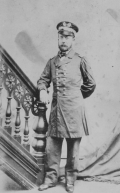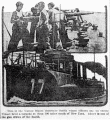Click On Image
For Full Size Image |
Size |
Image Description |
Contributed
By And/Or Copyright |
 |
77k | Joseph B. Smith, born in Belfast, Maine, in 1826, was appointed to the U.S. Naval Academy in 1841. After graduating with the Class of 1847, he served at the Washington Navy Yard, in USS Mississippi and with the U.S. Coast Survey. He was promoted to the rank of Lieutenant in 1855, and soon afterwards was assigned to the steam frigate Merrimack, his station until 1857. Smith next had ordnance duty at the Washington Navy Yard, D.C. Lieutenant Smith joined USS Congress in about 1859. As her Executive Officer, he was in charge of the ship during the Commanding Officer's absence when she was attacked and destroyed by CSS Virginia on 8 March 1862. Joseph B. Smith was killed in action during this battle. Photo #: NH 44970. Lieutenant Joseph B. Smith, USN, photographed by Black, 173 Washington St., Boston, Massachusetts, circa 1861. Lieutenant Smith was killed in action while serving as acting commander of USS Congress during her 8 March 1862 battle with CSS Virginia. U.S. Naval Historical Center Photograph. | Bill Gonyo |
 |
44k | USS Smith (DD-17) photographed on 21 September 1909, shortly before she was delivered to the Navy. | Robert Hurst |
 |
31k | starboard side line drawing by A.D. Baker III of USS Smith (Destroyer # 17) as she appeared in 1910. Image scanned from U.S. Destroyers: An Illustrated Design History by Norman Friedman. | Robert Hurst |
 |
431k | USS Smith (Destroyer # 17) At anchor, 1910. Naval History & Heritage Command photo NH 43763, enhanced by George Lane. The last class of coal fired ships, Funnel arrangement differs between ships depending on who built them. | Original: Fred Weiss
Replacement: George Lane |
 |
152k | USS Smith underway sometime between 1910 to 1915. Image taken by the Bain News Service. Photo courtesy of the Library of Congress. The photographer may be in error in identifying this ship as the Smith, note the funnel arrangement. It may be the USS Lamson (DD-18) or the USS Flusser (DD-20). If you know for sure please let us know. | Bill Gonyo/Jonathan Eno |
 |
103k | USS Smith (Destroyer # 17) Securing from action stations, just prior to entering New York Harbor in late March 1917. Courtesy of the Naval Historical Foundation, Washington, D.C. Collection of Captain R.T. Merrill. U.S. Naval Historical Center Photograph. The 1st class of destroyers designed to protect the battle line from enemy torpedo boats, the design emphasized guns over torpedoes and seakeeping and endurance over speed. Image from U.S. Destroyers: An Illustrated Design History by Norman Friedman. | Fred Weiss/Robert Hurst |
 |
103k | USS Smith (Destroyer # 17) Tied up at the Battery, New York City, "to hurry the recruiting", circa February-March 1917. Photographed by Kadel & Herbert, New York. U.S. Naval Historical Center Photograph. | Fred Weiss |
 |
198k | Newspaper clipping from the Mexico Missouri Message dated May 10 1917. | Mike Mohl |
 |
867k | Sailors man Smith's forward gun, circa 1917. | George Lane |
 |
656k | Smith's forward torpedo tubes deployed for action, circa 1917. | George Lane |
 |
95k | Sinking of USS President Lincoln, 31 May 1918 Survivors on board USS Warrington (Destroyer # 30), at left, and USS USS Smith (Destroyer # 17), at right, after they were rescued, about 1 June 1918. The donor, a member of Warrington's crew at the time, comments: "We had to transfer some men to the Smith as we had too many men to feed." Courtesy of Gustavus C. Robbins, 1973. U.S. Naval Historical Center Photograph. | Fred Weiss |

